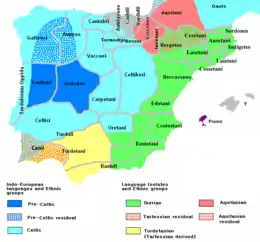سلتيأيبيرون
سلتيأيبيرون مجموعة من شعوب الكلت وCelticized التي تقطن وسط شرق شبه الجزيرة الإيبيرية خلال القرون قبل الميلاد. تم ذكرهم صراحة على أنهم سلتيون من قبل العديد من المؤلفين الكلاسيكيين (مثل Strabo [1] ). تحدثت هذه القبائل اللغة السلتيبيري وكتبتها عن طريق تكييف الأبجدية الأيبيرية. [2] سمحت النقوش العديدة التي تم اكتشافها، للعلماء بتصنيف اللغة السلتيبيريّة كلغة سلتيك، إحدى لغات الهيسبانو السلتيّة (المعروف أيضًا باسم السلتية الإيبيرية) التي كانت تُتحدث بلغة ما قبل الرومانية والرومانية المبكرة ايبيريا. آثاريا، العديد من العناصر تصل Celtiberians مع الكلت في أوروبا الوسطى، ولكن أيضا تظهر اختلافات كبيرة مع كل من ثقافة هالستات وثقافة لاتين.

لا يوجد اتفاق كامل على التعريف الدقيق للكيلتيبيريين بين المؤلفين الكلاسيكيين، ولا العلماء الحديثين. من الواضح أن نهر إبرة يفصل المناطق السلتيبيريّة عن الشعوب الناطقة غير الهندية الأوروبية. [3] في اتجاهات أخرى، يكون ترسيم الحدود أقل وضوحًا. [4]
أصل المصطلح
يظهر مصطلح Celtiberi في حسابات ديودور الصقلي، [5] أبيان [6] ومارتياليس [7] الذين أدركوا التزاوج بين Celts وIberians بعد فترة من الحرب المستمرة. " [8] [1] اعتقد بليني الأكبر أن الموطن الأصلي للكيلت في أيبيريا هو إقليم سلتيك في الجنوب الغربي، على أساس هوية الطقوس المقدسة واللغة وأسماء المدن. [9]
التاريخ
التاريخ المبكر

يستشهد سترابو باعتقاد إفوروس أنه كان هناك سلتيون في شبه الجزيرة الإيبيرية حتى قادس. [10] أظهرت الثقافة المادية للمناطق الشمالية الغربية من شبه الجزيرة الأيبيرية استمرارية من نهاية العصر البرونزي (القرن التاسع قبل الميلاد) حتى استوعبت بالثقافة الرومانية (القرن الأول قبل الميلاد). [11]
ملاحظات
- Strabo. Geography. Book III Chapter 4 verses 5 and 12. الوسيط
|CitationClass=تم تجاهله (مساعدة) - Cremin, Aedeen (2005). "Celtiberian Language". In Koch (المحرر). Celtic Culture: A Historical Encyclopedia. Volume I: A–Celti. Santa Barbara, CA: ABC-CLIO. صفحات 363–364. ISBN 978-1-85109-440-0. مؤرشف من الأصل في 20 سبتمبر 2019. الوسيط
|CitationClass=تم تجاهله (مساعدة) - Roman History, Book XVIII "Cato sailed away and reached Spain, where he learned that all the inhabitants as far as the Iberus (Ebro river) had united in order to wage war against him in a body. After organizing his army he attacked and defeated them and forced them to submit to him, since they feared that otherwise they might lose their cities at a single stroke. At the time he did them no harm, but later, when some of them incurred his suspicion, he deprived them all of their arms and caused the natives themselves to tear down their own walls. For he sent letters in all directions with orders that they should be delivered to everybody on the same day; and in these he commanded the people to raze their walls immediately, threatening the disobedient with death. The officials upon reading the letters thought in each case that message had been written to them alone, and without taking time for deliberation they all threw down their walls. Cato now crossed the Iberus, and though he did not dare to contend with the Celtiberian allies of the enemy on account of their number, yet he handled them in marvellous fashion, now persuading them by a gift of larger pay to change front and join him, now admonishing them to return home, and sometimes even announcing a battle with them for a stated day. The result was that they broke up into separate factions and became so fearful that they no longer ventured to fight with him."
- The Celts in Iberia: An Overview, e-Keltoi: Volume 6 https://www4.uwm.edu/celtic/ekeltoi/volumes/vol6/6_4/lorrio_zapatero_6_4.html
- Celtiberian manners and customs in Diodorus Siculus v. 33–34; Diodorus relies on lost texts of بوسيدونيوس.
- Appian of Alexandria, Roman History.
- Bilbilis was the birthplace of مارتياليس.
- Cunliffe, Barry (2003). The Celts: a very short introduction. Oxford University Press. صفحة 52. ISBN 0-19-280418-9. الوسيط
|CitationClass=تم تجاهله (مساعدة) - Sir William Smith (1854), Dictionary of Greek and Roman Geography, Volume 2, Boston: Little, Brown and Company. نسخة محفوظة 29 ديسمبر 2019 على موقع واي باك مشين.
- LacusCurtius • Strabo's Geography — Book IV Chapter 4 en. II, book IV, chapter 4 (الطبعة Loeb Classical Library). London: Heinemann. 1923. اطلع عليه بتاريخ 29 فبراير 2020. الوسيط
|CitationClass=تم تجاهله (مساعدة); Invalid|script-title=: missing prefix (مساعدة) - Koch, المحرر (2005). "Iberian Peninsula, Celts on the". Celtic Culture: A Historical Encyclopedia. Volume I: A–Celti. Santa Barbara, CA: ABL-CLIO. صفحة 950. ISBN 978-1-85109-440-0. مؤرشف من الأصل في 20 سبتمبر 2019. اطلع عليه بتاريخ June 9, 2010. الوسيط
|CitationClass=تم تجاهله (مساعدة)
المراجع
- بوابة علم الآثار
- بوابة إسبانيا
- بوابة البرتغال
- بوابة ما قبل التاريخ
